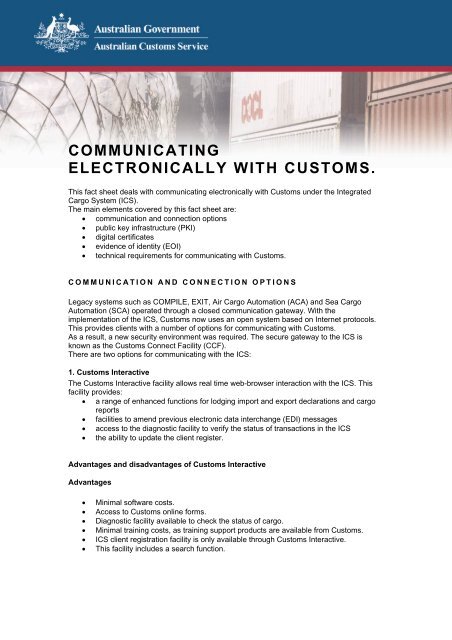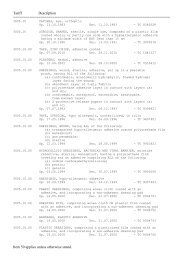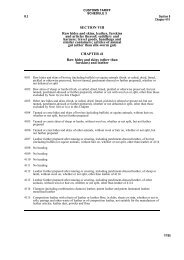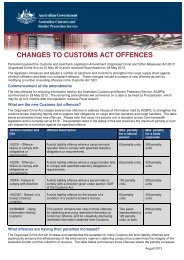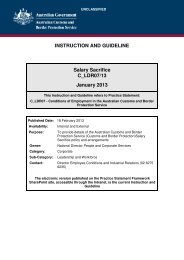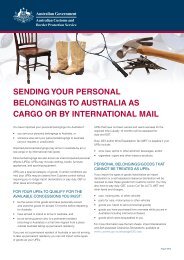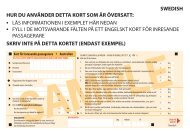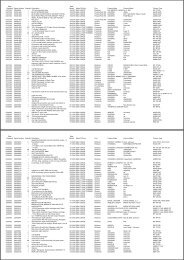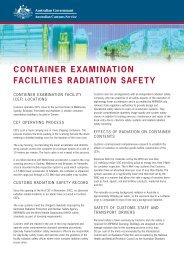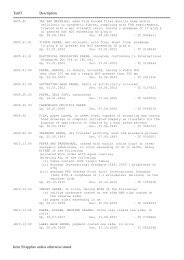SELF ASSESSED CLEARANCE DECLARATIONS - Australian ...
SELF ASSESSED CLEARANCE DECLARATIONS - Australian ...
SELF ASSESSED CLEARANCE DECLARATIONS - Australian ...
Create successful ePaper yourself
Turn your PDF publications into a flip-book with our unique Google optimized e-Paper software.
COMMUNICATING<br />
ELECTRONICALLY WITH CUSTOMS.<br />
This fact sheet deals with communicating electronically with Customs under the Integrated<br />
Cargo System (ICS).<br />
The main elements covered by this fact sheet are:<br />
• communication and connection options<br />
• public key infrastructure (PKI)<br />
• digital certificates<br />
• evidence of identity (EOI)<br />
• technical requirements for communicating with Customs.<br />
COMMUNICATION AND CONNECTION OPTIONS<br />
Legacy systems such as COMPILE, EXIT, Air Cargo Automation (ACA) and Sea Cargo<br />
Automation (SCA) operated through a closed communication gateway. With the<br />
implementation of the ICS, Customs now uses an open system based on Internet protocols.<br />
This provides clients with a number of options for communicating with Customs.<br />
As a result, a new security environment was required. The secure gateway to the ICS is<br />
known as the Customs Connect Facility (CCF).<br />
There are two options for communicating with the ICS:<br />
1. Customs Interactive<br />
The Customs Interactive facility allows real time web-browser interaction with the ICS. This<br />
facility provides:<br />
• a range of enhanced functions for lodging import and export declarations and cargo<br />
reports<br />
• facilities to amend previous electronic data interchange (EDI) messages<br />
• access to the diagnostic facility to verify the status of transactions in the ICS<br />
• the ability to update the client register.<br />
Advantages and disadvantages of Customs Interactive<br />
Advantages<br />
• Minimal software costs.<br />
• Access to Customs online forms.<br />
• Diagnostic facility available to check the status of cargo.<br />
• Minimal training costs, as training support products are available from Customs.<br />
• ICS client registration facility is only available through Customs Interactive.<br />
• This facility includes a search function.
Disadvantages<br />
• Internet service levels may require upgrading.<br />
• Information cannot be held or saved in the system during work in progress for export<br />
reports.<br />
• Electronic records cannot be stored on the users’ system.<br />
• No print functionality available for forms in the exports release; although a ‘print<br />
screen’ option may be utilised.<br />
2. Electronic data interchange<br />
Electronic data interchange (EDI) is a class of industry specific message formats used in<br />
electronic commerce. Customs Software Developers Guide details the messaging standards,<br />
specifications and the rules being applied by Customs to messages used by the ICS. There<br />
are many EDI software packages commercially available to industry; the Cargo Support<br />
website contains a list of relevant software developers.<br />
Clients may connect via the Internet for EDI, or alternately, clients with high volumes may find<br />
it more cost effective to have a direct connection to Customs. Clients who are interested in a<br />
direct connection should read the Direct connections to Customs Connect Facility (CCF) fact<br />
sheet.<br />
Those clients that arrange to purchase their own software through a software developer<br />
should seek advice on appropriate connection options either from the software developer or<br />
Customs.<br />
Advantages and disadvantages of EDI<br />
Advantages<br />
• Ability to store records.<br />
• Declarations and cargo reports can be held, saved, amended, printed and<br />
retransmitted.<br />
• Ability to batch transactions.<br />
• Option for other business enhancements to software, such as accounting and<br />
auditing functions.<br />
Disadvantages<br />
• Higher set-up and maintenance costs.<br />
• Software reliability and impact of downtime.<br />
• Potential costs of training staff.<br />
PUBLIC KEY INFRASTRUCTURE<br />
What is public key infrastructure?<br />
In line with the Commonwealth Government’s Gatekeeper strategy for supporting the security<br />
of online transactions with government, public key infrastructure (PKI) is being used to<br />
provide Customs and Customs clients with assurance that messages received from each<br />
other are genuine, and that the sender can be legally identified. PKI is the security<br />
mechanism for communications in a global and open network. It uses encryption to protect<br />
transmitted data from or to Customs. A digital certificate and associated ‘keys’ verify who is<br />
communicating and the integrity of the communicator’s data. The digital certificate is the<br />
electronic equivalent of the hand written signature and sealed envelope process.<br />
The security features of PKI include:<br />
• authentication (knowing who the message is from)<br />
• integrity (knowing it has not been tampered with)<br />
• non-repudiation (knowing that the sender cannot deny having sent it)<br />
• confidentiality (knowing that no unauthorised reading has occurred).
DIGITAL CERTIFICATES<br />
What is a digital certificate?<br />
A digital certificate should be considered as an electronic signature of either an individual<br />
and/or related entity. The digital certificate exists as a software file and is housed within webbrowsers.<br />
A digital certificate creates a unique identifier that can be checked by the receiver<br />
of information to provide evidence of the sender’s identity and confirm that the document (if<br />
signed) has not been altered or interfered with.<br />
A digital certificate actually contains two separate certificate parts (each with public and<br />
private keys); one for signing (authenticating) and another for encrypting/decrypting electronic<br />
messages.<br />
Who needs a digital certificate?<br />
A digital certificate will be required by any organisation or person in the exporting, importing,<br />
brokering, forwarding, cargo reporting, cargo carrying/handling and related industries who will<br />
communicate directly with Customs electronically.<br />
These include:<br />
• service providers - for example brokerages, cargo reporters, freight forwarders and<br />
bureaus<br />
• exporters, importers, and cargo reporters who communicate directly with Customs<br />
and who do not use service providers to communicate with Customs - if you use a<br />
service provider for some functions (for example to lodge import or export<br />
declarations) but intend to communicate directly with Customs for other functions (for<br />
example to use the diagnostic facility) you will still need to have a digital certificate<br />
• software developers for the purpose of developing software<br />
• Customs Interactive users.<br />
How many digital certificates will be needed?<br />
All direct electronic communicators will need at least one digital certificate. The number of<br />
certificates required by a business will be dependant on the IT setup and the method of<br />
communicating with Customs.<br />
For those businesses that plan to use EDI, the software developers who supplied the EDI<br />
software will be able to provide advice and assistance.<br />
Types of certificates<br />
There are five types of certificates available from certification authorities (CAs) for<br />
communicating with Customs, depending on the nature of the communicator.<br />
Type 1 - grade 2 individual certificates<br />
For users who are operating as an individual, where the digital certificate identifies and<br />
authenticates them personally.<br />
Type 2 - grade 2 non-individual certificates<br />
For organisations without an <strong>Australian</strong> Business Number (ABN), where the digital certificate<br />
identifies the organisation and the individual.<br />
Type ABN-DSC grade 2 certificates<br />
For organisations with an ABN (including sole traders and government agencies). The initial<br />
certificate will be issued to an authorised officer in the organisation. The authorised officer can<br />
then organise for additional certificates to be issued for other individuals within the<br />
organisation. These certificates will then be issued by the CA.<br />
Type 3 (device) certificates<br />
The type 3 (device) certificate will not authenticate human entities. This is a device or serverbased<br />
certificate for organisations whose communications are signed by a server. This will be<br />
of direct relevance to businesses that use EDI to communicate with Customs. To obtain a<br />
type 3 (device) certificate, an applicant must have an ABN and obtain a type ABN-DSC<br />
certificate. The applicant must already have an ABN-DSC certificate in order to apply to the<br />
CA for a type 3 certificate.
Type 3 Host (Device) certificates<br />
A Type 3 Host (Device) certificate is for use where your organisation wants a device<br />
certificate to be hosted by another organisation, called a host bureau.<br />
You will need a Type 3 Host (Device) certificate if you require a host bureau to:<br />
• communicate import declarations to Customs on your behalf<br />
• host your digital certificate and private keys.<br />
To obtain a Type 3 Host certificate you must first obtain an ABN-DSC Authorised Officer<br />
certificate. You must also have registered your ABN DSC details with Customs.<br />
For more information about Type 3 Host (Device) certificates, go to the ‘bureaus’ page on the<br />
Cargo Support website, located at http://www.customs.gov.au/site/page.cfm?u=5608.<br />
Customs expects that most clients who communicate via EDI will use type 3 (device)<br />
certificates. As these clients will also be ABN holders they will require a nominated employee<br />
within the organisation to be an authorised officer and hold a type ABN-DSC certificate. For<br />
businesses that plan to lodge import declarations in the ICS, the authorised officer must be<br />
the owner of the consignment or a licensed broker. That person can then seek additional<br />
certificates for others in the organisation who are required to communicate with Customs via<br />
Customs Interactive.<br />
In addition to Customs and its clients, the parties involved in the digital certificate process are:<br />
• Certification Authority (CA) - the CA issues digital certificates. The only approved CA<br />
currently able to issue digital certificates for communicating with Customs is VeriSign.<br />
Further information about VeriSign certificates can be found at www.verisign.com.au<br />
• Registration Authority (RA) - the RA processes evidence of identity. The RA for<br />
VeriSign purposes is Australia Post. Details of other Customs and Gatekeeper<br />
approved CAs and RAs will be posted on the Customs website as they become<br />
available.<br />
EVIDENCE OF IDENTITY<br />
Clients wishing to obtain a digital certificate may need to undertake an evidence of identity<br />
(EOI) check at a RA. An EOI check is required for type 1, type 2 and the authorised officer<br />
ABN-DSC certificates. To have an EOI check, clients will first need to complete an application<br />
for a digital certificate through a Customs approved CA. This will be done electronically.<br />
Clients will then need to take the application form and relevant identification documents to the<br />
RA (eg, an authorized Australia Post outlet).<br />
A guide to the required identification documents appears at the end of this fact sheet. The<br />
application fee for type 1 and type 2 certificates will be paid to the RA at the time of the EOI<br />
check.<br />
Getting the certificate<br />
For type 1 and type 2 certificates, once the EOI is verified by the RA, the RA will notify the<br />
CA. The CA will then issue a digital certificate to the client via email. Once EOI has been<br />
completed, the digital certificate will be available within five working days.<br />
Important: The CA will actually issue each digital certificate via two emails; one for the<br />
signature certificate part and another for the encryption/decryption certificate part.<br />
Both these digital certificate parts must be downloaded to complete the process.<br />
For those obtaining an authorised officer ABN-DSC, a subscriber agreement will need to be<br />
completed, signed and returned to the CA prior to the application and issue of digital<br />
certificates. The CA will send the subscriber agreement to the contact officer after receiving a<br />
request to establish an account (through their website).<br />
Therefore, it is advisable that clients allow 10 working days to complete this process and<br />
obtain a digital certificate.<br />
Important: You will be asked to provide the CA and RA with an email address. You must<br />
ensure this is the email address you wish to use in your communications with Customs. For a<br />
client to unlock an ICS email from Customs, the address used by Customs must match the<br />
email address in the certificate unlocking the email. It is also important to note that the digital<br />
certificate must be downloaded to the same computer/browser from which the enrolment form<br />
was originally downloaded from the CA. This is a necessary security requirement.
The certificate will be issued in the name of the applicant. For ABN holders, the initial<br />
certificate will be issued to the authorised officer in the ABN name of the organisation. Once a<br />
digital certificate has been issued to an authorised officer, that person is entitled to process<br />
EOI for subsequent members of the organisation. The authorised officer will forward the<br />
names of additional staff requiring certificates to the CA via the CA’s website.<br />
Registering the certificate<br />
Important: Before a digital certificate can be used with the ICS, a registration process must<br />
be completed. For full details on how to complete this process refer to the Digital Certificate<br />
and Client Registrations - Revised Processes fact sheet available at www.customs.gov.au.<br />
How long do certificates last?<br />
All certificates must be renewed every two years, with the exception of type 3 (device)<br />
certificates. There will be the option with type 3 (device) certificates to purchase either a one<br />
year certificate or two year certificate. If a certificate is to be renewed in the same company or<br />
individual name, new EOI will only be required every six years. The CA will stipulate what is<br />
required when a change occurs in an organisation, for example when there is a new<br />
authorised officer, when issuing the certificate.<br />
Important: Renewed digital certificates actually contain different data elements to their<br />
original version. Therefore, the renewed digital certificate details must be re-registered in the<br />
CCF.<br />
Certificate costs<br />
Certificate costs may vary depending on the CA. Listed below are the current costs of digital<br />
certificates that are available from VeriSign. All prices are inclusive of GST and are correct at<br />
time of printing.<br />
Type New Renewal<br />
Type 1 grade 2 $126.50 $93.50<br />
Type 2 grade 2 $137.50 $93.50<br />
ABN-DSC authorised officer<br />
(AO)<br />
ABN-DSC (non-AO) $93.50 $93.50<br />
Type 3 (device) - 1 year $319.00 $319.00<br />
Type 3 (device) - 2 year $594.00 $594.00<br />
$187.00 [$126.50 for additional<br />
AO] $93.50<br />
TECHNICAL REQUIREMENTS FOR COMMUNICATING WITH<br />
CUSTOMS<br />
Clients must have the following minimum IT requirements in order to communicate with<br />
Customs:<br />
• Microsoft Windows 2000 or XP<br />
• email which supports ‘PKCS 12’ format digital certificates (check this with the<br />
company you are using)<br />
Microsoft Internet Explorer 5.5 (Service Pack 2) or above<br />
• 56 KBPS modem or better (Broadband connection recommended)<br />
• 1024 x 768 or above screen resolution<br />
• 16 bit colours screen setting.<br />
CHECKLIST FOR DOING BUSINESS WITH CUSTOMS<br />
1. Determine how you will communicate with Customs - via Customs Interactive and/or EDI.<br />
2. If you are using EDI you should liaise directly with your software provider.<br />
3. Determine how many digital certificates you or your business will need.<br />
4. Contact VeriSign and complete the process (including EOI) for obtaining a digital<br />
certificate.<br />
5. Complete the registration process with Customs including the signing of the User<br />
Agreement (see separate Digital Certificate and Client Registrations - Revised Processes fact<br />
sheet).
EVIDENCE OF IDENTITY REQUIREMENTS<br />
Minimum EOI requirements to obtain certificates for type 1 grade 2 and type 2 grade 2<br />
certificates are:<br />
• EOI documentation to the value of 100 points in accordance with the Financial<br />
Transaction Reports Act 1998 Form 201 - Identification Record for a Signatory to an<br />
Account (Annex A). It is<br />
• mandatory that one of the three listed primary documents be produced<br />
• a face-to-face interview with the registration authority at the time the documents are<br />
presented<br />
• a current photograph (if not provided with a primary document).<br />
Where a name shown in one of the three listed primary documents differs from the name<br />
shown in any other document, proof of the reason for that name change must be provided.<br />
This proof does not count towards the 100-point check.<br />
Minimum EOI requirements to obtain certificates for type ABN-DSC and type 3 certificates<br />
are:<br />
• an original or certified copy of the notice issued by the Registrar of the <strong>Australian</strong><br />
Business Register (ABR) bearing the business entity’s name and the ABN. If either<br />
the owner, chief executive or other named officer or employee with clear capacity to<br />
commit the business entity, is named as the public officer on the document issued by<br />
the Registrar of the ABR, then this document will suffice, or<br />
• if the notice issued by the Registrar of the ABR cannot be provided then: a legal or<br />
regulatory document binding either the authorized officer or the authoriser with a clear<br />
capacity to commit the business entity, to the business entity (in this case online<br />
verification with the ABR to link the organisation’s ABN to its business name must be<br />
achieved), and<br />
• EOI documentation to the value of 100 points using the Financial Transaction Reports<br />
Act 1998 Form 201 - Identification Record for a Signatory to an Account (Annex A). It<br />
is mandatory that one of the three listed primary documents be produced, and<br />
• a face-to-face interview with the registration authority at the time the documents are<br />
presented, and<br />
•<br />
• a current photograph (if not provided with a primary document).<br />
Where a name shown in one of the three listed primary documents differs from the name<br />
shown in any other document, proof of the reason for that name change must be provided.<br />
This proof does not count towards the 100-point check.<br />
FOR MORE INFORMATION<br />
Go to www.customs.gov.au, email cargosupport@customs.gov.au or phone 1300 558 099.<br />
November 2006.


